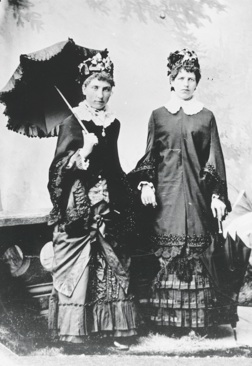Bertha












Bertha Augusta Rosnow
Bertha Rosnow was a lovely young lady in this photo. It appears from her clothing that it was probably taken in the late 1870s or early 1880s when Bertha was close to twenty years old. The focus of the fashionable silhouette at that time was the “hourglass figure”. This was achieved by reducing the waist size through the use of extremely tight-laced corsets. By 1878, the corsets were long an covered the entire hips as well. They not only reduced the waist size but also exaggerated the hip size. They were extremely curvaceous and produced this hourglass effect. Her hair is piled neatly on top of her head and she wears a necklace or locket that she also wears on the next photo that was taken from a tintype. This photo might also have been originally taken from a tintype because it is from a Milwaukee studio and has the name “Fiesenheuser” on the back. Bertha’s sister, Mary, married a Fiesenheuser and they lived in Milwaukee. Mary was about 6 years younger than Bertha and wasn’t married until late 1889 and that’s a little late for the hourglass style in this photo.

Bertha Rosnow With Her Sister, Mary Rosnow
The clothing worn by Bertha and Mary Rosnow indicate that this photo was taken about 1883 or a little later. Bertha may well have been married when it was taken. She married Julius Ziebell on March 21st, 1883 but he died sometime in 1884. Their only son, William was born in December of 1884 probably after his father’s death. This might have been her wedding dress. In 1883 there was a fashion surge into this type of dress. The Victorian period produced some incredibly ornate clothing and this is an excellent example of that. This was particularly true of the second bustle period in the 1880s. The cold-weather fabrics used between 1880 and 1885 were so heavy, that period is often called the Upholstered Women’s Fashion Era. In this photo we can see the heavily layered underskirts over which Bertha (left) wears her polonaise. This dress design originated in Poland, hence its name. It was a dress with the skirt divided in front and worn looped up over an elaborate underskirt. There is a profusion of ruffles, pleats, lace and bows on both dresses. Both ladies wear full-sleeved, long jackets over their dresses with ornate white collars or neck-pieces, and Bertha has the same necklace in this photo, as in the earlier one. Flowered hats and fancy parasols complete their outfits. Bertha carries her parasol opened showing off its ruffled fringe. What an unbelievably fanciful period that was--but perhaps just a bit overdone? Each era has its own style and personality, doesn’t it? This era certainly did! The photo was taken from a tintype that happily survived in with the family memorabilia.

Above is a much later photo of the sisters for comparison. The two were obviously very close through the years. Although they show the obvious changes of aging, their facial features are still recognizable. It’s always fun to compare earlier and later photos to see how we change with age--but change, we do! And there’s no denying it, is there? By this time they were (left) Mary (Rosnow) Fiesenheuser of Milwaukee, Wisconsin and (right) Bertha (Rosnow) Ruth of Clintonville, Wisconsin.





